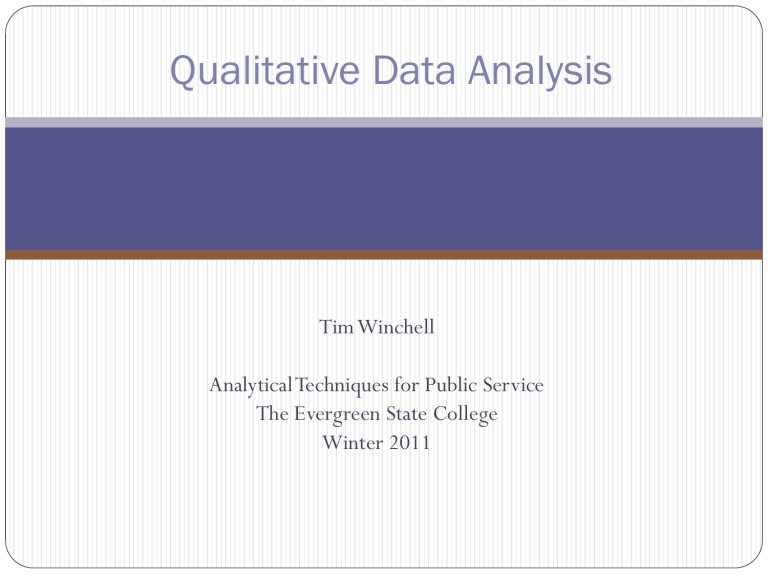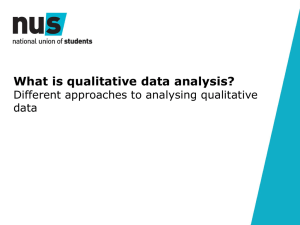Making Sense of Qualitative Data
advertisement

Qualitative Data Analysis Tim Winchell Analytical Techniques for Public Service The Evergreen State College Winter 2011 “It wasn’t curiosity that killed the cat. It was trying to make sense of all the data curiosity generated.” -Halcolm Qualitative Data “Qualitative Data… have been gathered during the conduct of interpretive or postpositivist research studies. They exist most often as some sort of narrative.” Examples include: Written text Conversation, interview, or consultative transcriptions Focus group transcriptions Field notes Diaries Legal transcripts Newspaper clippings Journal or magazine articles Photographs Maps Illustrations Paintings Musical scores Tape recordings Films (McNabb, p. 368) Advantages Grounded in a specific context/situation Real life events/ settings; lived experience Deep layers of meaning; rich description filled with differing perspectives, symbolism, metaphor, and meaning. “Descriptions form the bedrock of all qualitative reporting.” (Patton, p. 438) “The devil is in the details.” Difficulties Labor intensive Research Bias Requires creativity Cost of processing/coding Conceptual sensitivity Non- formulaic (Polit & Beck, p. 570) data Small sample size, many variables Very limited generalizability Credibility One Synopsis of the Challenges “The challenge of qualitative analyses lies in making sense of massive amounts of data. This involves reducing the volume of raw information, sifting trivia from significance, identifying significant patterns, and constructing a framework for communicating the essence of what the data reveal… There are no formulas for determining significance. No ways exist of perfectly replicating the researcher’s analytical thought processes. No straightforward tests can be applied for reliability and validity. In short, no absolute rules exist except perhaps this: Do your very best with your full intellect to fairly represent the data and communicate what the data reveal given the purpose of the study.” (Patton, p. 432-433) Data Management The complexity of the project drives the level of organization needed Format field notes consistently Index notes, so you can find documents easily Make sure you can read them! Have a sensible system for cross referencing your notes Please remember to: Maintain data confidentiality as much as possible Secure your data when not in use Maintain participant confidentiality And… Another Data Back Up Reminder! “Thomas Carlyle lent the only copy of his handwritten manuscript on the history of the French Revolution, his master work, to philosopher J. S. Mill, who lent it to Mrs. Taylor. Mrs. Taylor’s illiterate housekeeper thought it was waste paper and burned it. Carlyle behaved with nobility and stoicism, and immediately set about rewriting the book. It was published in 1837 to critical acclaim and consolidated Carlyle’s reputation as one of the foremost men of letters of his day. We’ll never know how the acclaimed version compared with the original or what else Carlyle might have written in the year lost after the fireplace calamity.” (Patton, p. 441- emphasis added) Your General Approach? Grounded Start data collection with few preconceived notions about what’s going on….no pre-formed coding scheme) ….or Framed? Specific events, behaviors you intend to look for, with coding scheme already partially developed. Oftentimes use diagrams to explain ideas. All analyses benefit from diagramming and concept mapping, as Babbie discusses (p. 405). Qualitative Analysis: The General Process Data Reduction Coding Data Display Conclusion Drawing These are not linear, but concurrent processes The less “framed” and more grounded the process, the more they are concurrent: constant comparison Data Reduction First, we transform data from field notes or transcriptions Write up and/or transcribe field notes and print. Which of the data are most useful? “Developing some manageable classification system or coding scheme is the first step of analysis. Without classification there is chaos and confusion. Content analysis, then, involves identifying, coding, categorizing, classifying, and labeling the primary patterns in the data.” (Patton, p. 463) Consider…. For extensive research projects, summarize interviews with a brief cover sheet Who, what, where, when, importance, summary of key contacts Coding schemes…must match the complexity of the project Use similar semantics Identifying concepts, patterns, memos What is Coding? In short, codes are shorthand descriptors of: Setting and context Subjects’ perspectives, which could include their thinking about people and objects Processes, activities, and/or strategies Relationships and social structures Any preassigned coding schemes (Bogdan & Biklen, 1992, p. 166-172, as quoted in Creswell, p. 193) Creswell recommends analyzing data using codes readers would expect to learn more about, find surprising, and address larger theoretical issues in the literature. (p. 193) Variations…. Start categorizing early… Or ….. Dive deeper into the data and avoid making judgments too early… make tentative observations about what might be happening…. To further analyze what is happening: Write memos to yourself Use “concept mapping” (Babbie, p. 405) Build preliminary typologies Try to use outcome/ process matrices (Patton, p. 468-477) Open Coding….One Approach Start with a sample of the data Read responses carefully… Keep research questions in mind Make rough categories of these descriptors that seem to belong together and code them with a key word. Utilize constant comparison- similarities and differences. Work to saturation. Farm to School Example Why do local farmers participate in the local farm to school program? Resp.1: It makes the most business sense to me…. Possible code: ‘business sense,’ busin. Resp. 2:“It gives me great pride to think of my organic produce being consumed locally by my family members, friends, and church members and their children. Possible code: “service,” serve Farm to School Example Business Sense (Busin.) Service (Serve) 1. Most business sense 1. Belief in organic produce being consumed locally 1. Organic production for nuclear family, friends, & church members & their children 2. Service to local community 5. Some contribution to local school district (lower prices received) 3. Reduces transport costs 3. Ability to hire more 4. Reduces environmental impact- transport 6. Stability of local school district market Write ongoing memos and abstracts Comprehending: The Basic Goal of this Stage Identify important phenomena Identify broad themes Document codes that emerge Begin to speculate about what might be happening Write ongoing memos and abstracts Axial Coding Explore the relationships between and among codes Look for: “Contexts Causal Conditions Phenomenon central ideas Strategies for addressing the phenomenon Intervening conditions Action/ interactions Consequences” (Gibbs video) Develop subcategories, linked by a “paradigm.” Paradigm includes conditions, actions/ interactions, and consequences (Polit & Beck, p. 584) Employee Self Care Example How could agencies promote employee self care in their organizations? Organizational Changes (OrgCh.) Employee Changes (EmpCh.) Policies Health Education Management Training Supervisory Best Practices Employee Awareness Initiatives Medical Coverage Incentives Individual Health Surveys/ Contracts/ Teaming Employee Best Practices Selective Coding Identify core phenomenon Develop story line around the core concept(s) Compare and contrast the core concept(s) to other selective coding categories (Gibbs video) Findings are integrated and refined Include diagrams (Polit & Beck, p. 584) Data Display Playing with typologies and displays is a part of the analysis process See Miles and Huberman, Qualitative Data Analysis Make sense of the data by playing with visual means of representing the patterns that are emerging from the analysis Process and outcome flow charts/ matrices “Interpretation, by definition involves going beyond the descriptive data. Interpretation means attaching significance to what was found, making sense of findings, offering explanations, drawing conclusions, extrapolating lessons, making inferences, considering meanings, and otherwise imposing order on an unruly but surely patterned world.” (Patton, p. 480) Theorize: Cause and Effect? Classic Conditions for Establishing Cause and Effect Variables Covary Covariance is not spurious Logical time order A lucid explanation is available Or …clusters of phenomena, identify things that tend often to show up together, even if the causal connection is not clear Qualitative Analysis- Visually Analysis of Medical Errors “Figure 1 classifies the stage in the diagnostic testing process and the transition points within and between stages at which errors can occur, and presents representative occurrences that fall into each of them.” (Harris, et al.) Early Introduction of Soft Foods by Young Mothers Verification Triangulate from multiple sources or methods Use several researchers as a reliability check. Use rich, thick description in order to provide for the shared experience Clarify research bias up front Look for disconfirming evidence Spend prolonged time in the field to develop an in-depth understanding Use peer debriefing Use an external auditor to review findings (Creswell, p. 196) Complete several case studies. (Yin, 2003) Review finding with participants. If it’s just you, double or triple check your data and conclusions Standards Be true to the data Don’t get too carried away by particularly eloquent, memorable, or “simple” respondents—this creates a cognitive bias Always check and recheck both the data and conclusions you draw from it Qualitative Validity Traditional Criteria for Judging Quantitative Research Alternative Criteria for Judging Qualitative Research Internal validity Credibility External validity Transferability Reliability Dependability Objectivity Confirmability (Trochim, 2006) Drawing Conclusions Summary of data and results of coding analysis Patterns and themes Clusters of similar findings? Case comparisons Powerful metaphors Any data for which your theory can’t provide a reasonable explanation? Final Thoughts Data Management and Analysis work hand in hand Coding is technical work, which is improved upon with advanced practice, study, and interpretation Remember to consult additional resource materials (Some are listed at the end of the PowerPoint) Utilize the Internet judiciously Qualitative data software resources are reviewed in many publications and on-line Workshop Case: TESC Alumni Relations Research Interest Why do colleges and universities have alumni programs? Research questions What are TESC graduates’ perceptions of TESC’s alumni programs? What kind of alumni program do they want? How do they recall their experience as TESC students? What connects them to the College? What nourishes that connection? What can AR do to improve those connections? Workshop Methods/ Results Overview Draft questions; approval from Alumni Relations Zoomerang online survey 1647 responses One researcher Pluses: clear conclusions, grounded in data Minus: not validated by second researcher Workshop Exercise Code 2 or 3 pages of the data from the responses to the Alumni survey question. “What was the best part of your experience at Evergreen?” Code individual responses What are the most common codes? What do these data tell you/us about these alumni ? About Evergreen? Resources YouTube Search “qualitative research coding” Graham R. Gibbs Qualitative Research Coding Series Open Coding: http://www.youtube.com/watch?v=gn7Pr8M_Gu8 http://www.youtube.com/watch?v=vi5B7Zo0_OE&fe ature=related http://www.youtube.com/watch?v=nEomYWkxcA&feature=related http://www.youtube.com/watch?v=AwmDRh5l7ZE& feature=related Resources YouTube Search “qualitative research coding” Graham R. Gibbs Qualitative Research Coding Series Axial Coding: http://www.youtube.com/watch?v=s65aH6So_zY&feature=r elated Selective Coding: http://www.youtube.com/watch?v=w9BMjO7WzmM&featur e=related Grounded Theory: http://www.youtube.com/watch?v=4SZDTp3_New&feature =related http://www.youtube.com/watch?v=dbntk_xeLHA&feature= related Morgan, D. L. (1997). Focus Groups as Qualitative Research (2nd Ed.). Sage Publications: Thousand Oaks, CA. Software Resources Computer Programs: See Babbie, p. 406-416 Data analysis strategies for qualitative research- Research Corner http://findarticles.com/p/articles/mi_m0FSL/is_6_74/ai _81218986/?tag=content;col1 Software for qualitative research http://homepages.vub.ac.be/~ncarpent/soft/soft_softsites .html Software for qualitative research http://www.audiencedialogue.net/soft-qual.html References Babbie, E. (2010). The Practice of Social Research (12th Ed.). Wadsworth Publishing: Belmont, CA. Creswell, J. W. (2003). Research Design: Qualitative, Quantitative, and Mixed Methods Approached (2nd Ed.). Sage Publications: Thousand Oaks, CA. Harris, et al. Mixed Methods Analysis of Medical Error Event Reports: A Report from the ASIPS Collaborative http://www.ncbi.nlm.nih.gov/bookshelf/br.fcgi?book=aps2&part=A 2024 McNabb, D. E. (2002) Research Methods in Public Administration and Nonprofit Management: Quantitative and Qualitative Approaches. M.E. Sharpe: Armonk, NY. References II Miles, M. B., & A.M. Huberman. (1994). Qualitative Data Analysis. (2nd Ed.). Sage Publications: Thousand Oaks, CA. Patton, M. Q. (2002). Qualitative Research & Evaluation Methods (3rd Ed.). Sage Publications: Thousand Oaks, CA. Polit, D. F., & Beck, C. T. (2004). Nursing Research: Principles and Methods (7th Ed.). Lippincott Williams & Wilkins: New York, NY. Trochim, William M. K. (2006). Research Methods Knowledge Base. http://www.socialresearchmethods.net/kb/qualapp.php Yin, R. K. (2003) Case Study Research (3rd Ed.). Sage Publications: Thousand Oaks, CA. Acknowledgements Making Sense of Qualitative Data TESC MPA Program ATPS Winter 2010 Geri/Gould/McBride







